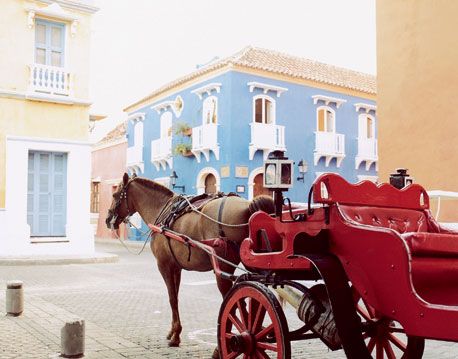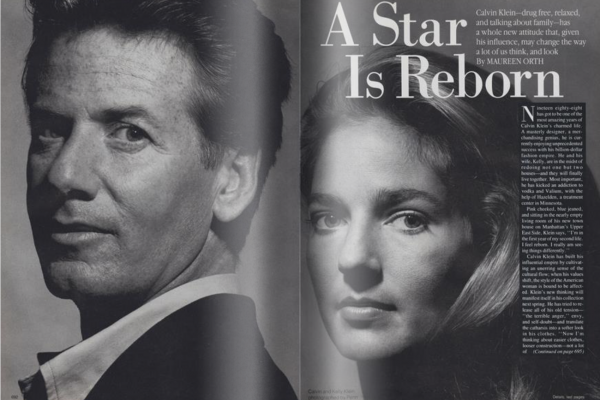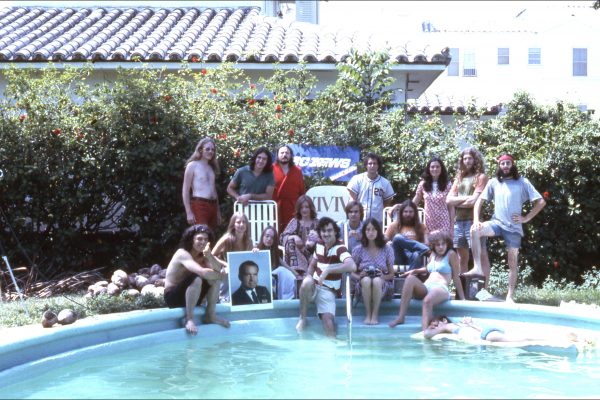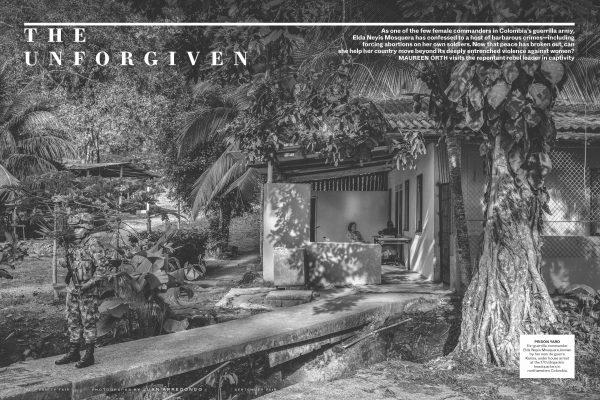Town & Country, November 2010
If Cartagena’s old colonial walls could talk, what stories they would tell. In the seductive seaside city Gabriel García Márquez calls home, there’s magic, and the occasional bit of the macabre, on every cobblestoned street.
Rafael del Castillo and I had never met, but a mutual friend put us in touch before I left for Cartagena. “Rafa” came from one of the leading families there and had married a former beauty queen. “The night you arrive, come to dinner at my house,” he wrote in an e-mail. “I’ll pick you up.” True to his word, Rafa appeared promptly at my hotel and brought me to his home, the top-floor apartment in a gleaming twelve-story glass and concrete building in the Bocagrande area. The slick boutiques and luxury residential towers of this chic stretch of waterfront, bordering a peninsula just south of the city’s colonial center, sprang up only in the past decade. Today Bocagrande, which has some of Colombia’s most expensive real estate, is the neighborhood of choice for those who prefer, and can afford, ocean-side modern.
I’d expected an intimate evening en familia, but when I walked into his place, I found a twenty-person party he’d arranged in my honor. Each guest kissed me on the cheek in welcome: the editor of the Cartagenan daily, El Universal; the director of Cartagena’s film festival; the local head of Avianca airlines. Toya Maldonado, former director of Colombia’s tourism promotion fund, took one look at my itinerary and began rearranging it: I was not to miss a sunset sail; it should be dinner, not lunch, at trendy La Vitrola. And of course I had to go to “the islands,” the Islas del Rosario and the larger Barú, forty-five minutes by boat from several harbors and filled with exotic birds above and colorful fish below.
I had not been to Cartagena (pronounced car-ta-hay-na) since 1995, so I was happy simply to gaze out the window of Rafa’s apartment at the metropolis, one shaped by gold, pirates, Catholicism and slavery. Across the bay, on the highest point in Cartagena, was La Popa, the imposing white 17th-century convent. Directly north was the original fortified city that everyone comes to see. Cartagena’s most notable monument, the giant fortress of San Felipe de Barajas, was lit like a movie set and bathed in a golden glow.
My nose was still pressed to the glass when the seviche appetizer was served. I had forgotten how much Colombians like to talk about what they eat — almost as much as Italians do. “Have you tasted our special fresh cow’s-milk cheese?” a guest asked me as servers set down silver platters for a sumptuous buffet. “It is hard to get anywhere else, and it gives a particular flavor to many of our dishes.” (Cartagenan cuisine is a rich mixture of Spanish, African, Creole and Arab influences, a reflection of the city’s shifting population during the past four centuries.) The dinner, consisting of shrimp in creamy lemon sauce, filet mignon with caramelized onions and the local specialty, brown rice with raisins and coconut milk, plus many side dishes and three glorious desserts, was a grand reintroduction to the hospitality of the costeños, the millions of people who live along the nearly 2,000 miles of Colombian coastline.
When it comes to Colombia, I confess that I’m not a disinterested observer. I fell passionately in love with the country back in the sixties, as a Peace Corps volunteer. Today the Escuela Marina Orth, a school for thirty-five students I helped build in the mountains above Medellín, is thriving, with 350 pupils from kindergartners through high schoolers. In 2004, I started a foundation to fulfill a request from Medellín’s secretary of education to help make the escuela the first public bilingual and high-tech school in Colombia.
Forty years ago, the only major hotel in the city was venerable El Caribe, which is still open, and we volunteers considered it a big treat to share a room for twenty-five dollars a day. We used to stay up half the night on the beach dancing to the rhythms set by musicians we hired for six dollars and a bottle of rum. Excursions to fishing villages up the coast were in a rented dugout equipped with an outboard motor, and often as we arrived, the fishermen’s children would run naked through the water to greet us. There is still too much poverty here, but I recently read that the last native fisherman in Cartagena sold his half-acre of Bocagrande beachfront property, including his cinder-block shack, to developers for $1 million.
Who could have known how our old stomping grounds would be transformed? Inside the old, walled section—the ciudad amurallada — the shabby-genteel mansions of 16th- and 17th-century viceroys and counts, their flower-laden wooden balconies hanging over narrow cobblestoned streets, have been turned into boutique hotels for Europeans and Brazilians and holiday homes for Colombia’s rich. So many couples choose to be married in the glamorous city, in fact, that a number of smart shops sell only white clothes.
The biggest reason for the renewed tourist interest in Cartagena, though, is the dramatic improvement in safety in Colombia under President Álvaro Uribe. In the past six years, his government has managed to subdue a substantial portion of endemic violence bred from unequal income distribution, political unrest and drug trafficking, breaking a pattern four decades old. As a result, the country has been able to embark on a full-fledged tourism campaign: “Colombia es pasión.”Colombians themselves now drive to Cartagena from Bogotá, the capital, eighteen hours away, and from Medellín, ten hours away, unthinkable acts just a few years ago. Americans can walk the city center at night without fear.
Granted, for all of Colombia’s recent bloody history, Cartagena was always an exception. Fortresses were erected around the city in the 16th and 17th centuries to protect its wealth and ensure the safety of the Spanish galleons carrying gold and silver away from the New World. There is still only one narrow waterway into Cartagena, guarded by a fort on each side. I had toured the forts and massive stone barricades on previous visits. They are full of dark passages the Spanish constructed with slave labor to repel pirates and other enemies after Sir Francis Drake sacked Cartagena, in 1586. When British admiral Edward Vernon — greatly esteemed by George Washington’s half-brother, Lawrence, who served with the admiral and named Mount Vernon for him — arrived in 1741, with 24,000 soldiers and 186 ships to capture the city for the British, the forts held. Vernon’s troops were defeated by a greatly outmanned Spanish force and its one-armed, one-legged, one-eyed comandante.
The sense of Cartagena’s severe history, forged in these epic battles, is hard to shake off. One of the city center’s most fascinating sights is the museum at the Palacio de la Inquisición, where from 1776 through 1821, hundreds of accused apostates were tortured and tried for heresy, although only five were put to death. The museum features a scale on which those suspected of being possessed were weighed and judged according to an ancient Greek ideal: if you were too fat, you were said to be filled with demons; if you were too thin, you had the ability to fly and were therefore a witch.
Nearby is the Iglesia de San Pedro Claver, named for a Jesuit who made himself what he called “the slave of the slaves” by baptizing and ministering to thousands of them in the 1600s. His remains rest in the altar, and you can visit the room in the adjacent convent where he died. But even this saintly advocate for human rights was given a slave to tend to him as he was dying. (The Cartagena slave market, the largest in the New World, was held in the Plaza de los Coches.)
The Spanish did not capture potential slaves themselves but bought them from the Portuguese and the Dutch. Today in the city’s small, shady plazas, where costumed performers sing and dance, and especially on the Islas del Rosario and Barú, the overwhelmingly poor and dark-skinned, often blue- and green-eyed descendants are a reminder that there is a legacy of slavery still. I attended Sunday Mass at San Pedro Claver on the saint’s feast day; a priest explained to a group of children, who were mostly black and were making their First Communion, that Pedro Claver believed in the dignity of everyone. The boys were resplendent in starched white shirt and gloves; the girls wore long white ruffled dresses and wreaths of flowers atop their curls.
Coming upon such a timeless scene by chance is, for me, what defines Cartagena. You can feel the same tropical heat, duck into the same cool, dark churches and walk the same curved, narrow streets so many others did so many hundreds of years ago and feel as if you were moving in and out of centuries. Moreover, the magic realism conjured by native bard Gabriel García Márquez, “Gabo” to the locals, continues to permeate the city. During breakfast amid the tropical plants on the patio of the luxe Hotel Sofitel Santa Clara, feeding papaya with a fork into the bright green beak of a toucan named Mateo, I couldn’t help but imagine it could rain butterflies any minute.
So surreal is the history of the Santa Clara — it was a convent for some two hundred years, then a city hospital — that García Márquez, whose house is next door, set his beguiling 1995 novella Of Love and Other Demons there. In the book, a young girl is bitten by a rabid dog and banished to the Santa Clara to be exorcised; after she dies, her cascades of copper-colored hair continue to grow. It is no coincidence that the author wrote it while observing the excavation of the convent’s crypts. This sort of exotica endures within the hotel: one night I joined a group of Colombian journalists being treated to a six-course dinner in the deconsecrated chapel. Petals were scattered among gigantic candlesticks on the thirty-foot linen runner covering the immense refectory table; each of us was attended by a footman dressed as a hooded monk. I could practically hear the ghosts of those who once manned the kitchens singing in Yoruba, Kongo and Mandingo.
Admittedly, the Cartagena of my youth was a lot dirtier and small-seeming. It is hard to believe cruise ships now dock here. During one of my first visits, I bought a pair of gold hoop earrings right from the ears of a woman seated under a banana tree, her pottery spread out in front of her skirts. The earrings’ gold, which came from the jungle on the Caribbean coast, was so pure that it bent in my fingers. In those days the open-air market was bawdy and vibrant; women walked through it barefoot, balancing tubs of fruit on their heads. Now that old market has been banished to make way for a spotless convention center.
And yet Cartagena’s spirit and authenticity remain. A year ago Bill Clinton arrived to help celebrate García Márquez’s eightieth birthday, which coincided with the fourth International Congress of the Spanish Language, an event that drew some of Latin America’s greatest living writers as well as the king and queen of Spain. Describing the difference between these festivities and the celebration of his winning the Nobel Prize in literature in 1982, Gabo himself said, “That was Stockholm. This is Cartagena. The party is much bigger here.”
That line sprang to life for me when I paid a visit to the grande dame of Cartagena, Teresita Román de Zurek, whose father invented Kola Román, the city’s most popular soft drink. Now eighty-one, Señora Román still lives in the amazing Moorish-style gingerbread house she was born in. This kind of imposing home, built in the 19th and early 20th centuries, after Colombia gained its independence from Spain, is rapidly disappearing. But not the Casa Román. “I will never move,” Señora Román declares. Off the ornately tiled indoor patio, itself a copy of the Alhambra, in Granada, Spain, she exhibits her astounding collection of more than 1,300 porcelain dolls.
The señora also wrote a famous cookbook, Cartagena in the Pot, which was translated into English. That afternoon her kitchen was bustling. Dozens of tiny tarts were baking. Her numerous parrots squawked in their cages. The enormous graveled garden behind the patio had been taken over by at least fifty four-year-olds, most of whom had arrived in chauffeur-driven cars, accompanied by nurses in white uniforms, to celebrate the birthday of one of Señora Román’s grandsons. It was yet another scene fit for a novel.
After the revelry of the city, I wanted to disappear into the islands. Cartagena is not known for great beaches, but the deep blue water surrounding the twenty-seven coral-reef islands that make up the Islas del Rosario archipelago is bathtub warm and perfect for snorkeling. Built on land that once belonged to a French painter who apparently decided to imitate the life of Gauguin, the Hotel San Pedro de Majagua has private thatched-roof bungalows and an “enchanted lagoon” filled with shimmering plankton. Boutique resorts, like the Hotel Agua Barú, are also beginning to appear.
My own beautifully appointed bungalow at the Agua had a private pool. And since the bungalow was a daunting 165 stone steps up a steep hill from the main building, I thought room service would be preferable to going back down for dinner and then up again. Thunder had sounded since dusk, and an intense tropical downpour began around nine. Lightning streaked the sky every few seconds; the thunder was so loud, it seemed to be right outside the door. I finally slept, fitfully, under the ten-foot-high canopy of mosquito netting.
The morning’s gray skies didn’t last long, and by afternoon the sun was back at full strength. I planned to spend the day outdoors, immersed in the crystal-clear waters and verdant vegetation. After Brazil, Colombia has the largest variety of flora and fauna in the world, and the Rosarios are home to more than 2,500 species of plants, animals, birds and fish. At any moment, you may see hundreds of white egrets, wild roosters, herons, pelicans and parrots.
On the Isla de San Martín, a modern-day Robinson Crusoe named Rafael Vieira has established Oceanario, a funky natural aquarium: wired-off pens at sea level contain endangered species of fish and turtles; rust-colored cat sharks let themselves be petted and fed by hand. Accompanied by a trainer, I waded into a tank and played with Swanee, a friendly dolphin. Vieira is determined to bring attention to the ecological wonders of the region, as well as to its fragility. “I came here as a teenager in 1975 and never left,” he says. “I started collections of living things I wanted to save.” His latest project is a massive six-acre aviary that will house 116 species of birds from all over the world. He told me to cross the channel to Barú and have a look.
As I strolled there under the banana and coconut palms, in and out of cages filled with rare birds munching on fruit and seemingly unafraid of humans, I had to pinch myself: in Cartagena, things fantastical and magical do so often tend to be real.
Native Intelligence
Tips for planning your trip to Cartagena
When calling the telephone numbers below from the United States, first dial 011-57-5 unless otherwise noted.
When to Go
Cartagena enjoys tropical weather nearly year-round, with temperatures averaging 88 degrees. Mid-November through February is the best time to visit, as the months after the brief rainy season (October through the beginning of November) are often the least humid.
How to Get There
Rafael Núñez International Airport is three miles from downtown (ten minutes by taxi). Colombia’s national carrier, Avianca (800-284-2622; avianca.com),flies from Miami to Cartagena daily (2.5 hours) and from New York via a connecting flight through Bogotá (6.5 hours).
The luxury British-run travel agency Dehouche (011-55-21-2512-3895;dehouche.com) is based in Brazil and specializes in South America. Its consultants are fluent in English and expert at arranging highly customized itineraries. In January, Cox & Kings (800-999-1758; coxandkingsusa.com)launched a tour that includes Cartagena.
Lay of the Land
Cartagena comprises a peninsula on Colombia’s northern coast and many islands nearby. The ciudad amurallada (old city) is made up of three main neighborhoods: El Centro, home to most of the historic plazas, churches and museums; San Diego, an affluent residential area; and the island of Getsemaní, where the city’s artisans and minority groups (Jews, Muslims) once lived. Bocagrande and El Laguito, the tony beach communities, are on the peninsula; to the southwest are the Rosario archipelago and the island of Barú.
Getting Around
Inside the city’s colonial center, almost any site is a short stroll away. (You can traverse the entire historic area in less than half an hour.) Taxis are inexpensive, accessible and safe. Horse-drawn carriages are widely available if a bit pricier.
Where to Stay
The Hotel Agua, a six-room boutique hotel, is in a renovated 17th-century tobacco factory. The decor is Spanish colonial — it’s filled with antiques — yet the rooftop pool is utterly chic. Agua also rents bungalows on Barú. Double rooms from $315, suites from $365, bungalows from $415. 4–29 Calle Ayos, El Centro; 664-9479; hotelagua.com.co.
The Hotel Charleston Cartagena was once a convent; today the refectory table at the entry holds a gigantic arrangement of heliotropes and birds-of-paradise. Guests enjoy spacious rooms, Turkish baths and a pool overlooking the sea.Double rooms from $320, suites from $365. 31–23 Plaza Santa Teresa, El Centro; 664-9494; hoteles-charleston.com.
Also a former convent, the Hotel Sofitel Santa Clara is now a 120-room luxury retreat with seventeen suites and a pool scene much like that at the Beverly Hills Hotel. The cast of Love in the Time of Cholera, the movie adaptation of García Márquez’s novel, stayed here. Double rooms from $340, suites from $365. Calle del Torno, San Diego; 664-6070; sofitelsantaclara.com.
LaHeroica.com rents private restored colonial houses, including staff, by the day or the week. Request the Casa Baloco, a seven-bedroom gem, or the Casa Don Sancho, a palatial ten-bedroom house with a wine cellar and a pedigree: the groundwork for Cartagena’s independence was laid here (weekly rentals from $16,000). LaHeroica.com also arranges stays at the Hotel LM (double rooms from $390, suites from $495), an exclusive boutique property that doesn’t allow children under ten. 011-57-316-522-0630; laheroica.com.
Where to Eat
Since the 1950s, the Club de Pesca has welcomed seafood lovers to its terrace, which offers views of the neighboring ramparts and sailboat-filled marina. Reservations are suggested. Fuerte de San Sebastián del Pastelillo, Manga; 660-7065.
Folk art decorates the courtyard at El Santísimo, but the star here is the Caribbean food of French-trained chef-owner Federico Vega: sautéed shrimp in tamarind sauce; mango mousse in a pastry shell. 8–19 Calle del Santísimo, El Centro; 664-3316.
Bullfighter-actor-restaurateur Juan del Mar owns a handful of hip spots. His latest venture, the Mesa Peruana, serves Peruvian fusion food. Lasagna by way of Lima, anyone? Plaza de San Diego, San Diego; 664-5108.
Asian-inspired cuisine is served at the Restaurante San Pedro, overlooking the Iglesia de San Pedro Claver. Go at night, when the square is buzzing with activity and bathed in the light of the balconied houses all around. 31 Plaza de San Pedro Claver, El Centro; 664-5121.
The convivial Paco’s evokes Rick’s Café in Casablanca. The septuagenarian Veteranos del Ritmo (Veterans of Rhythm) play Colombian music on weekends while diners enjoy tapas and fish dishes. Plaza de Santo Domingo, El Centro.
Havana-themed La Vitrola, around the corner from García Márquez’s home, is among the city’s most popular spots, so book a table in advance. Its black-and-white photos and ceiling fans recall an earlier era. 2-01 Calle Baloco, El Centro; 664-8243.
Nightlife
Like its namesake, on Ibiza, the picturesque Café del Mar sits atop a fortress wall. It’s a great place to have a drink and watch the sunset. Baluarte de Santo Domingo, El Centro; 664-6513.
Impromptu dance parties on the beach are not quite as popular as they were in the ’60s, but there’s still music after dark everywhere: at Comarca (3–38 Calle Santo Domingo, El Centro; 664-9960), a former antiques shop that’s now a nautical-themed bar; Quiebra Canto (25–1119 Carrera 8B, 2nd floor, Getsemaní; 664-1372), a candlelit bar favoring the songs of Celia Cruz and other legends; and Tu Candela (32–35 Portal de los Dulces, El Centro; 664-8484),where Latin pop and salsa entertain the throngs.
In addition, on Saturday evening, wealthy residents and worldly travelers linger at café tables, artisans sell jewelry, and guitarists serenade the crowds in thePlaza de San Diego.
What to Do
The Castillo de San Felipe de Barajas, a huge fortress, overlooks the walled city. Visitors can walk its ramparts and some of its secret tunnels. Avda. Arévalo, Pie del Cerro; 656-0590.
Cartagena’s churches are integral to its history. But the Iglesia de San Pedro Claver is especially beloved, for the missionary whose work it honors: the city’s patron saint of slaves. Plaza de San Pedro Claver, El Centro; 664-7256.
A natural aquarium on one of the Islas del Rosario, Oceanario is stocked with endangered fish and turtles. Don’t miss the tame sharks. The Rosarios and Barú are forty-five minutes away from Cartagena via a day boat that departs regularly from the Muelle Turístico La Bodeguita harbor, near El Centro and Bocagrande.laheroica.com.
Cartagena’s main square has had many names: the current one, the Plaza de Bolívar, honors the country’s liberator, General Simón Bolívar. Performers often fill this handsome park, at whose center stands a statue of Bolívar on horseback. Flanking the square are some of the city’s most important buildings, including the Palacio de la Inquisición (664-7381).
Where to Shop
Galería Cano stocks authentic pre-Columbian jewelry and high-end handicrafts.Plaza de Bolívar, El Centro; 664-7078.
Great summer jewelry, like chandelier earrings with bright beads, is sold at reasonable prices at María Camila Mesa. 33–41 Calle Nuestra Señora del Carmen, El Centro; 664-5754.
Calle San Juan de Dios, in El Centro, is home to some of Colombia’s most famous fashion designers, like Silvia Tcherassi (No. 31–11; 664-9410) andHernán Zajar (No. 3–25; 664-0171). ~M.O.
Original Publication: Town & Country, November 2010.





No Comments